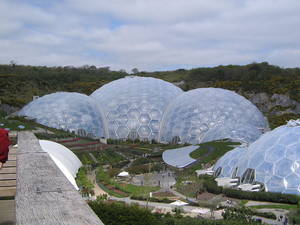New Greenhouse Gases - Planet Earth Online
Interview with
Chris - As if carbon dioxide and methane aren't enough to worry about, it now seems that we're managing to make a whole load of new greenhouse gases too. A team including Johannes Laube at the University of East Anglia has identified several new manmade compounds that are contributing to global warming. These halogenated compounds, a bit like CFCs that are now banned, are only found in tiny concentrations, but their chemistry means that they're likely to stick around in the air for hundreds, if not thousands of years. Planet Earth podcast presenter Richard Hollingham went to meet Johannes in his basement laboratory...
Johannes - Basically - I have to reach up a bit - so these are air samples from Tasmania and is a man-made archive which goes back to 1978.
Richard - This metal cylindrical flask is among dozens hanging from the shelves that line the lab. Air inside these containers is reckoned to be some of the cleanest on the planet.
Johannes - You can get very clean air from Tasmania which actually has gone to Antarctica and back again to Cape Grim in Tasmania, then you get a representative picture of what the compound is doing on a long-term basis in the atmosphere.
Richard - The samples are studied using a machine at the centre of the room which resembles an over-sized photocopier. This mass spectrometer is able to separate and analyse air samples to identify minute concentrations of gases to find chemicals that shouldn't naturally be there.
Johannes - We're separating very small amounts of trace gases in the air from the main parts of it which are oxygen and nitrogen mainly and then we still have quite a mixture of different compounds - we have to separate them from each other. When we've done that we actually destroy them. By destroying them we can see a characteristic pattern and that pattern changes over time and gives us the information about which compound is coming through and how much.
 Richard - What are you interested in looking for, then?
Richard - What are you interested in looking for, then?
Johannes - I'm mainly interested in halogenated gases because some of them have very long atmospheric lifetimes, so once released it takes decades and sometimes centuries or even thousands of years for the atmosphere to break them down again. And these gases, are very often very strong greenhouse gases, so they are actually thousands of times more effective than carbon dioxide.
Richard - You're finding these chemicals for the first time in the atmosphere?
Johannes - Oh yes, because industry is introducing more and more new chemicals, it's very hard for scientists to keep pace. In addition, our ability to find them has improved significantly, so we can actually find parts per quadrillion in the atmosphere.
Richard - So parts per quadrillion?
Johannes - Yes.
Richard - But when you've got that tiny, tiny concentration of these gases, does it matter if they're greenhouse gases?
Johannes - Well, for instance, we've recently detected new perfluorocarbons in the atmosphere, but their abundances are on the order of just below parts per trillion. But that means several thousand tons of these molecules have been released into the atmosphere already and in addition they are very long lived, they won't go away for the next several thousand years. Once added into the atmosphere they become a permanent part of it.










Comments
Add a comment